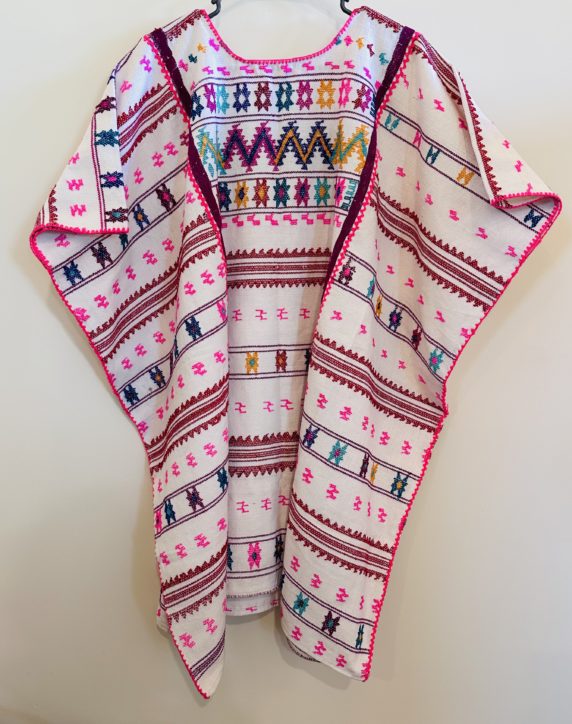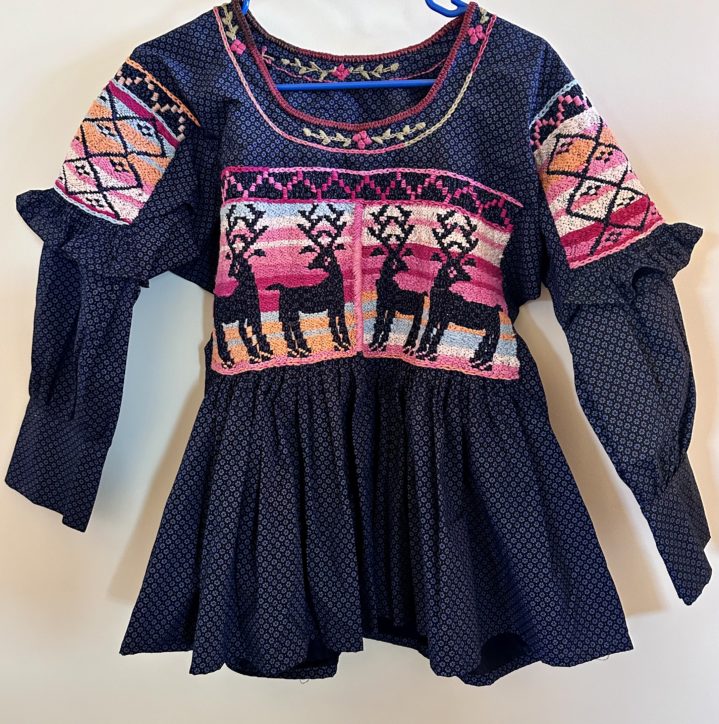Behind a tall wooden gate about six blocks from the Zocalo at #38 Guadalupe Victoria is the Museo de Trajes Regionales. The private collection of traditional indigenous dress is an inspiration of Sergio Castro Martinez, a former Chiapas state senator (2000-2003), engineer and lay healer. Señor Castro gives personal guided visits in French, English, Spanish and Italian. At the same time, he also ministers to those in need of health care at no cost.
As textile aficionados, we asked our B&B host Bela if she would contact Sr. Castro and make an appointment for us to visit the museum on the first day of our arrival in San Cristobal de las Casas. Visitors are asked to arrive at 6:00 p.m. As we approached, a woman exited the house with her head covered and accompanied by family members. Sr. Castro provides free care to people who have burn injuries and also for those with diabetes.
Several times during our guided visit, he excused himself to help a toddler brought in by his young mother, and then to care for an older man, and then to take urgent phone calls. He has been honored on multiple occasions by international and local civic and governmental groups for his humanitarian works.
The museum is a must-see for anyone interested in indigenous history, culture, and regional weaving/textile traditions. Sr. Castro explains in depth the differences between the tribal groups of the region, their languages, marriage and family customs, political and social systems, and the evolution and change in the costume design and materials used. He also, through his museum collection, shows the various special traje (dress) for the leaders of each village, as well as for weddings and other ceremonies. All the traditional dress in this region is created on fabric woven on back -trap looms.
This is an important orientation for anyone who wants to go out to explore the more accessible villages.
For example:
1. In the pueblo of San Juan Chamula, the traditional cape and skirt is made from black sheep wool that is woven on a back-strap loom. The long fibers are not cut but pulled out so that the garment has a wooly look to it, resembling the coat of the sheep itself. Sheep are family pets, used for their wool and are never eaten.
2. In the pueblo of Zinacantan the traditional color of the women’s chal (shawl) and agua (skirt), and the men’s poncho used to be pink or rose colored until about four years ago when there was a decided shift to the color blue, says Sr. Castro. The community grows flowers (there are greenhouses covering the mountain valley landscape) and this is reflected in the intricately embroidered (mostly by machine, some still by hand) floral and bird patterns on the cloth.
3. In Amantenango del Valle, the women create clay figures, mostly jaguars, chickens and roosters, but also ollas (jars), bowls, and other functional pieces. The women’s huipile is evolving. Traditional women wear a very geometric blouse with predominantly gold and red coloration. The newer design coming into vogue is a frilly collar that trims an embroidered bodice, all synthetic, shiny material. The ultimate adornment is a fancy pleated mandil or apron that goes over the top.
We also see traje from Aguatenango, Oxchul, Ocosingo, the intricate yellow, red and blue brocade diamonds from Las Margaritas, Pantelho, the red and black brocade weavings from San Andres Larrainzar. From Mayas Lacandones who live along the Usumacinta River that borders Guatemala, we learn the dress is bark that has been beaten and softened with a stick, then adorned with painted red colors representing the sun, moon and stars.
Visitors are asked to give a free-will offering (suggested minimum is 100 pesos per person)) for the explanation/tour that helps support Castro’s work. There is a small room that includes photographs of the severity of burns caused by carelessness, fireworks, and handheld firecrackers associated with ceremonies and rituals.
Rapid societal changes are having an impact on the weaving and its quality. There is widespread use of synthetic materials and alteration of styles and designs to suit the tourist market. Handwork is done on store-bought commercial fabric (synthetic polyester or cotton blend). It is no longer easy to find punto de cruz (needlepoint work) or hand embroidery using naturally dyed fibers.
This is the poorest state in Mexico. Many migrate in search of jobs. Younger people are shedding traditional dress as they desire to assimilate. Others move from villages to larger cities in search of employment.
Contact:
Sergio Castro Martinez, #38 Guadalupe Victoria, San Cristobal de las Casas, Chiapas, Mexico. Phone: 967-678-4289. sergiocastrosc@gmail.com




















Chiapas Textile Cooperative to Exhibit and Sell at Oaxaca Textile Museum
After calling ahead and making an appointment, we took a taxi to the outskirts of San Cristobal de las Casas at the end of a dirt road to find the headquarters of Camino de los Altos. This is a cooperative of 130 weavers who make extraordinary textiles.
They will be exhibiting and selling their work at the Museo Textil de Oaxaca from Friday through Sunday, February 17-19, 2012. If you are in Oaxaca, you won’t want to miss this event!
The cooperative began in the mid-1990’s by eight French designers who had a passion for Mayan traditions, textiles, and indigenous design. El Camino selects ancient traditional colors and re-imagines them. They produce bags, children’s clothing, pillow covers, scarves, shawls, table cloths, runners, napkins, and dish towels on sturdy, highest quality fabric that is hand-woven on back strap looms in five Chiapas weaving villages. Six sales are held each year in Paris and at other selected locations around the world.
Wool pillow covers can be the natural color of the sheep or dyed with either palo de Brazil or cochineal to yield a rich red. Mayan women then embellish them with traditional hand-embroidered designs. The cotton is dyed with industrial color. The color combinations are juicy and intense, and based upon traditional weaving patterns, too.
As a cooperative, the members meet together to decide next steps, new design and color directions, and pattern innovations. Their commitment is to each other — everyone must have work. The marketplace speaks, so together they determine what needs to be altered, adapted, changed or discontinued.
[Cultural note: In traditional villages, the men work in the fields and do required community service (cargos). Women are responsible for all the household work, and care for children and in-laws. We hear that many of the women who are now able to earn their own income through weaving and other crafts, choose not to marry to achieve some level of independence.]
El Camino de los Altos operates through the sale of their work and the support of a French foundation, and are able to employ four full-time staff. The money they earn goes directly to the weavers. In addition, they are training indigenous women in marketing, sales, production, inventory control and other business development aspects that will ensure ongoing success.
A Chiapas retail store, Madre Tierra, sells Camino de los Altos textiles. It is located across from the sweets market on Insurgentes in the courtyard behind the fabulous bakery that sells the most delicious whole grain onion garlic buns.
Contact: Veronique Tesseraud, director, elcaminodelosaltos@gmail.com, (967) 631-6944. Barrio de Cuxtitali, Cerrada Prolongacion Peje de Oro #3. http://elcaminodelosaltos.blogspot.com/
Like this:
8 Comments
Posted in Cultural Commentary, Oaxaca Mexico art and culture, Textiles, Tapestries & Weaving, Travel & Tourism
Tagged backstrap loom, blogsherpa, Chiapas, El Camino de Los Altos, fiber art, Mayan, Mexico, Oaxaca, textiles, weavers, women's cooperative